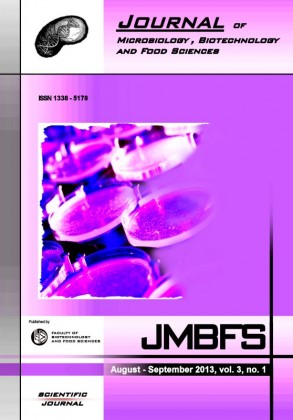PRODUCTION OF BACTERIOCIN EC2 AND ITS INTERFERENCE IN THE GROWTH OF SALMONELLA TYPHI IN A MILK MATRIX
Keywords:
Escherichia coli EC2, bacteriocin EC2, Salmonella Typhi, bacterial interference, milkAbstract
Bacterial interference can occur through various mechanisms, including the production of peroxides, acids, ammonia, bacteriolytic enzymes or bacteriocins. The strain Escherichia coli EC2 produces the antimicrobial substance (AMS) EC2, able to inhibit different strains of Gram-negative bacteria isolated from food, as E. coli and Salmonella sp. The activity of AMS EC2 was lost after treatment with proteolytic enzymes, indicating the presence of an active proteinaceous compound, suggesting that it is a bacteriocin. The substance, renamed bacteriocin EC2, has its better production when the producer strain is grown on Casoy medium, at 37ºC and pH 6.0, without NaCl addition, but it is also able to be produced in milk. When co-cultivated in UHT milk with the producer strain E. coli EC2, the growth of the indicator strain Salmonella Typhi is totally inhibited within the first 4 hours of incubation, suggesting a potential application of bacteriocin EC2 in the control of Salmonella sp. e.g. in foods.Downloads
Download data is not yet available.
Downloads
Published
2013-08-01
How to Cite
de Jesus Lopes de Abreu, Y., David Beserra Gomes, M., Rocha Fleming, L., Rachel de Britto Peçanha, B., & dos Santos Nascimento, J. (2013). PRODUCTION OF BACTERIOCIN EC2 AND ITS INTERFERENCE IN THE GROWTH OF SALMONELLA TYPHI IN A MILK MATRIX. Journal of Microbiology, Biotechnology and Food Sciences, 3(1), 26–29. Retrieved from https://office2.jmbfs.org/index.php/JMBFS/article/view/7071
Issue
Section
Microbiology
License
Copyright (c) 2013 Yuri de Jesus Lopes de Abreu, Mateus David Beserra Gomes, Luana Rocha Fleming, Bruna Rachel de Britto Peçanha, JanaÃÂna dos Santos Nascimento

This work is licensed under a Creative Commons Attribution 4.0 International License.
All papers published in the Journal of Microbiology, Biotechnology and Food Sciences are published under a CC-BY licence (CC-BY 4.0). Published materials can be shared (copy and redistribute the material in any medium or format) and adapted (remix, transform, and build upon the material for any purpose, even commercially) with specifying the author(s).

